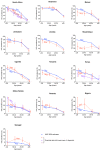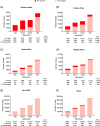Age-specific burden of cervical cancer associated with HIV: A global analysis with a focus on sub-Saharan Africa
- PMID: 34626498
- PMCID: PMC8732304
- DOI: 10.1002/ijc.33841
Age-specific burden of cervical cancer associated with HIV: A global analysis with a focus on sub-Saharan Africa
Abstract
HIV substantially worsens human papillomavirus (HPV) carcinogenicity and contributes to an important population excess of cervical cancer, particularly in sub-Saharan Africa (SSA). We estimated HIV- and age-stratified cervical cancer burden at a country, regional and global level in 2020. Proportions of cervical cancer (a) diagnosed in women living with HIV (WLHIV), and (b) attributable to HIV, were calculated using age-specific estimates of HIV prevalence (UNAIDS) and relative risk. These proportions were validated against empirical data and applied to age-specific cervical cancer incidence (GLOBOCAN 2020). HIV was most important in SSA, where 24.9% of cervical cancers were diagnosed in WLHIV, and 20.4% were attributable to HIV (vs 1.3% and 1.1%, respectively, in the rest of the world). In all world regions, contribution of HIV to cervical cancer was far higher in younger women (as seen also in empirical series). For example, in Southern Africa, where more than half of cervical cancers were diagnosed in WLHIV, the HIV-attributable fraction decreased from 86% in women ≤34 years to only 12% in women ≥55 years. The absolute burden of HIV-attributable cervical cancer (approximately 28 000 cases globally) also shifted toward younger women: in Southern Africa, 63% of 5341 HIV-attributable cervical cancer occurred in women <45 years old, compared to only 17% of 6901 non-HIV-attributable cervical cancer. Improved quantification of cervical cancer burden by age and HIV status can inform cervical cancer prevention efforts in SSA, including prediction of the impact of WLHIV-targeted vs general population approaches to cervical screening, and impact of HIV prevention.
Keywords: HIV; age-specific incidence rates; cervical cancer; population-attributable fraction; sub-Saharan Africa.
© 2021 World Health Organization. International Journal of Cancer published by John Wiley & Sons Ltd on behalf of UICC. This article has been contributed to by US Government employees and their work is in the public domain in the USA.
Conflict of interest statement
The authors declare no conflicts of interest.
Figures





Similar articles
-
Estimates of the global burden of cervical cancer associated with HIV.Lancet Glob Health. 2021 Feb;9(2):e161-e169. doi: 10.1016/S2214-109X(20)30459-9. Epub 2020 Nov 16. Lancet Glob Health. 2021. PMID: 33212031 Free PMC article.
-
The burden of human papillomavirus infections and related diseases in sub-saharan Africa.Vaccine. 2013 Dec 29;31 Suppl 5(0 5):F32-46. doi: 10.1016/j.vaccine.2012.07.092. Vaccine. 2013. PMID: 24331746 Free PMC article. Review.
-
Regional and country-level trends in cervical cancer screening coverage in sub-Saharan Africa: A systematic analysis of population-based surveys (2000-2020).PLoS Med. 2023 Jan 12;20(1):e1004143. doi: 10.1371/journal.pmed.1004143. eCollection 2023 Jan. PLoS Med. 2023. PMID: 36634119 Free PMC article.
-
Population risk factors for late-stage presentation of cervical cancer in sub-Saharan Africa.Cancer Epidemiol. 2018 Apr;53:81-92. doi: 10.1016/j.canep.2018.01.014. Epub 2018 Feb 4. Cancer Epidemiol. 2018. PMID: 29414636
-
Cervical cancer prevention and care in HIV clinics across sub-Saharan Africa: results of a facility-based survey.J Int AIDS Soc. 2024 Jul;27(7):e26303. doi: 10.1002/jia2.26303. J Int AIDS Soc. 2024. PMID: 38979918 Free PMC article.
Cited by
-
Design and characterization of SrO2-CMC-Dcar nanocomposite with enhanced antimicrobial, anticancer, and antioxidant activities.Naunyn Schmiedebergs Arch Pharmacol. 2025 Jul 9. doi: 10.1007/s00210-025-04415-1. Online ahead of print. Naunyn Schmiedebergs Arch Pharmacol. 2025. PMID: 40632155
-
Awareness, attendance, and attitudes toward cervical cancer screening among HIV-positive Chinese women in Yunnan province: a cross-sectional study.BMC Womens Health. 2024 Dec 4;24(1):636. doi: 10.1186/s12905-024-03478-1. BMC Womens Health. 2024. PMID: 39633302 Free PMC article.
-
Mapping Evidence on the Burden of Breast, Cervical, and Prostate Cancers in Sub-Saharan Africa: A Scoping Review.Front Public Health. 2022 Jun 16;10:908302. doi: 10.3389/fpubh.2022.908302. eCollection 2022. Front Public Health. 2022. PMID: 35784211 Free PMC article.
-
Comparative effectiveness of implementation strategies for Accelerating Cervical Cancer Elimination through the integration of Screen-and-treat Services (ACCESS study): protocol for a cluster randomized hybrid type III trial in Nigeria.Implement Sci. 2024 Mar 11;19(1):25. doi: 10.1186/s13012-024-01349-9. Implement Sci. 2024. PMID: 38468266 Free PMC article.
-
Merkel Cell Polyomavirus and their Association with the Pathogenesis of Cervical Squamous Cell Carcinomas and Adenocarcinomas: A Review Article.Ethiop J Health Sci. 2023 Jul;33(4):711-720. doi: 10.4314/ejhs.v33i4.18. Ethiop J Health Sci. 2023. PMID: 38784202 Free PMC article.
References
-
- Ferlay J, Ervik M, Lam F, et al. Global cancer observatory: cancer today. Lyon, France: International Agency for Research on Cancer. https://gco.iarc.fr/today. Accessed March 15, 2021. 2020.
-
- UNAIDS . Country factsheets. Rwanda 2020. Coverage of people receiving ART (all ages). https://www.unaids.org/fr/regionscountries/countries/rwanda Accessed 26 August, 2021.
Publication types
MeSH terms
Grants and funding
LinkOut - more resources
Full Text Sources
Medical
Research Materials

